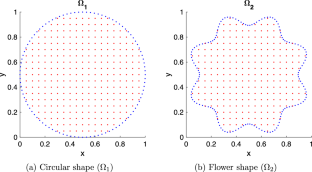Numerical simulation of the time fractional Gray-Scott model on 2D space domains using radial basis functions
Abstract
The Gray-Scott system describes one of the crucial components of the reaction-diffusion system. Its mathematical model has a couple of non-linear partial differential equations that are challenging to solve numerically. The present study is concerned with the numerical solution of the time-fractional Gray-Scott model in arbitrary-shaped domains utilizing the finite difference approximation and radial basis functions (RBFs) based collocation method for time and space directions, respectively. The patterns are created in the domains that denote the leftover chemical component concentrations at a specific time in the system. We also witness the effects of the time-fractional order \((\alpha )\) and diffusion constants (\(K_u\) and \(K_v\)) on the model. This study asserts that chemical reactions between two substances manifest chaotic and unpredictable behavior. Investigating the influence of time-fractional order introduces an intriguing avenue for exploring novel patterns and behaviors within this context. Furthermore, the proposed algorithm can be used to solve the model and generate novel patterns by altering the parameter values or geometric configurations in any space dimension.


 求助内容:
求助内容: 应助结果提醒方式:
应助结果提醒方式:


